Introduction
Here we've done our best to catalog the various periods and styles of American furniture and set them on a timeline, below. Our timeline is broken into pre and post Industrial Revolution. Examples are provided as well as links to pieces built by our members as presented in the SAPFM Members Gallery.
Fine furniture has been made throughout all periods in American history and in all styles. Because a piece is categorized in a post-Industrial Revolution period does not imply that it was factory made or that its construction or aesthetics is somehow inferior to earlier periods.
As an organization, SAPFM has focused much of its efforts on pre-Industrial Revolution furniture. That is not to say that our members are not interested in contemporary styles that emerged in the 20th century. Several pieces in the Member Gallery, articles found in our publications, and even a Cartouche Award recipient reflects this.
Periods and Styles
There is a clear distinction between periods and styles. Periods refer to a length of time during which furniture was built. Styles refer to a particular form or design elements used in the making of the piece.
Periods are somewhat fluid bands of time where a particular set of characteristics or elements were popular. Styles are created by makers to highlight the characteristics in vogue and design elements incorporated in their work. Periods do not have hard start or finish dates and styles show evolution as tastes changed. Makers, if they wanted to stay in business, would cross periods and styles as their clients' tastes changed. Just because a period or a style evolved into a new one, the durable goods bought with good money were held onto further blurring the beginning and ending dates of a period or style.
One thing is certain, no style or period is strictly limited to a single country. England, France, Germany, and Italy, all influenced each other and those were all influenced by the Greeks and Romans from ages gone by. In turn, America's influence was carried back to the “old country”. The Periods and Styles listed below cross countries just as the creators or texts from the creators crossed.
Authors do not agree on time-frames, if it is a period, a style, or a maker, even what to call the period or style. Many Periods were identified decades if not a century later by authorities and collectors looking back at the body of work created by makers in a given time period. Many period beginning dates are set by the earliest known piece identified by a specific maker or with a set of characteristics.
Pre-Industrial Revolution Timeline
The Industrial Revolution
The industrial revolution drastically altered furniture making. Beginning in 1760’s but not reaching wide acceptance until the 1820’s to 1840’s the use of machines replaced hand work in all areas. Slower to reach the furniture industry, starting in the 1860’s technology allowed furniture to be mass produced.


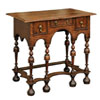 Influence from England and the Baroque styles in France and Italy.
Influence from England and the Baroque styles in France and Italy.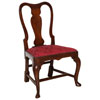 The Queen Anne style is lighter, more graceful, and smaller than its predecessors.
The Queen Anne style is lighter, more graceful, and smaller than its predecessors.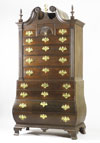 Both a style and a maker with comfort, proportion, and aesthetics being the focus.
Both a style and a maker with comfort, proportion, and aesthetics being the focus. The Pennsylvania Dutch style was predominant in the German settlements in Pennsylvania.
The Pennsylvania Dutch style was predominant in the German settlements in Pennsylvania.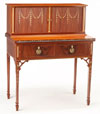 The Federal Period is the first truly American style of furniture. Includes: Sheraton, Hepplewhite, Goddard and Townsend, and Seymore styles.
The Federal Period is the first truly American style of furniture. Includes: Sheraton, Hepplewhite, Goddard and Townsend, and Seymore styles. The American Empire or Classical style featured C and S curved arms, and legs with highly carved lion’s paw.
The American Empire or Classical style featured C and S curved arms, and legs with highly carved lion’s paw.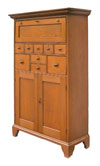 Shaker style was a distinctive American design of the “United Society of the Believers in Christ’s Second Appearing” more commonly known as the Shakers.
Shaker style was a distinctive American design of the “United Society of the Believers in Christ’s Second Appearing” more commonly known as the Shakers.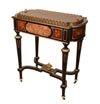
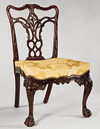 Referred to as the Naturalist Style. Advances in technology allowed for finer and more intricate carvings and laminated wood was introduced.
Referred to as the Naturalist Style. Advances in technology allowed for finer and more intricate carvings and laminated wood was introduced.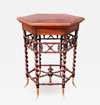 Aesthetic Style argued that there need not be a useful or practical purpose to art.
Aesthetic Style argued that there need not be a useful or practical purpose to art.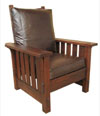 One of the strongest movements in furniture, was an attempt to put the heart back into the making of furniture.
One of the strongest movements in furniture, was an attempt to put the heart back into the making of furniture.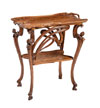 Introduced at the Paris Exhibition, the style was not widely accepted because it did not lend itself to easy manufacture.
Introduced at the Paris Exhibition, the style was not widely accepted because it did not lend itself to easy manufacture. Art Deco with crisp lines and controlled curves was more accepted than Art Nouveau.
Art Deco with crisp lines and controlled curves was more accepted than Art Nouveau.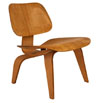 Incorporation of plastics, molded laminates, and aluminum; the manufacturing process allowed for single unit furniture pieces.
Incorporation of plastics, molded laminates, and aluminum; the manufacturing process allowed for single unit furniture pieces.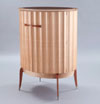 Studio Furniture is defined as one-of-a-kind or limited production of furniture objects designed and built by craftspeople.
Studio Furniture is defined as one-of-a-kind or limited production of furniture objects designed and built by craftspeople.